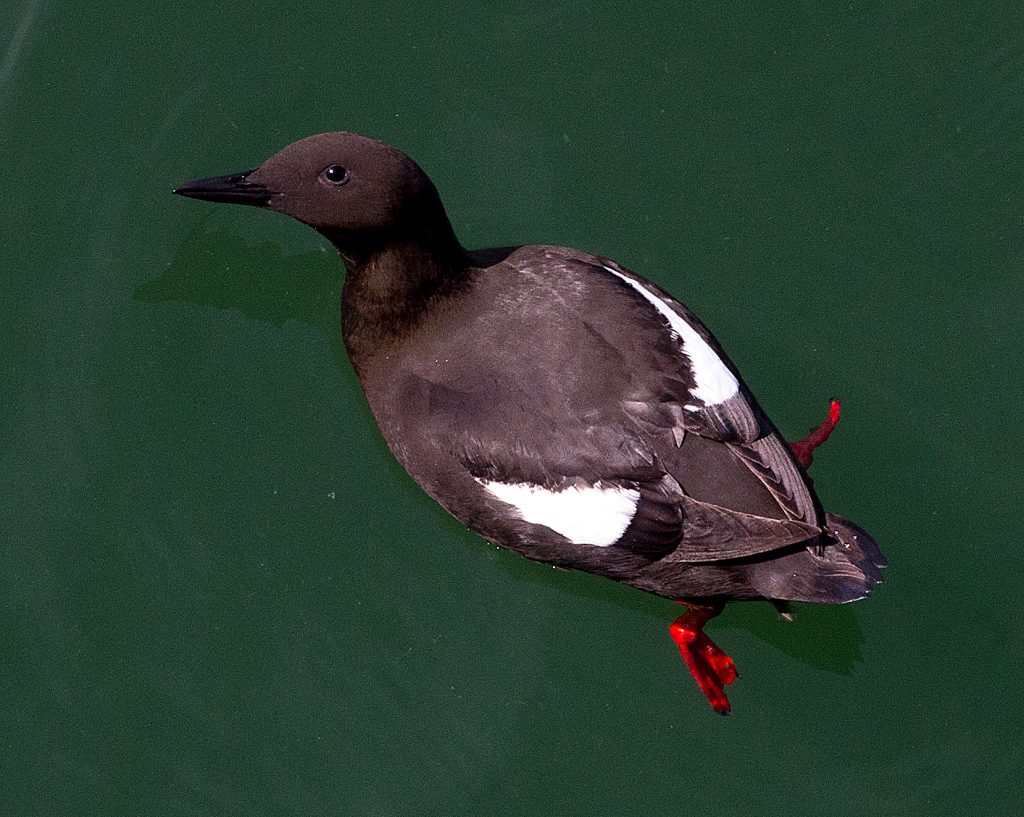 CLdN Heysham to Warrenpoint 3-4 April 2025
CLdN Heysham to Warrenpoint 3-4 April 2025
03 April 2025
It is always a pleasure to survey from CLdN’s ships as they cross the Irish Sea. The crew and captains are universally welcoming, hospitable and often interested in our work. In addition to the warm welcome, spring was in the air with much warmer temperatures and reasonably smooth conditions both ways.
Many people, surveyors included, enjoy seeing seabirds but are positively excited by marine mammals. On this survey we had a treat with three species of marine mammals! A couple of Harbour Porpoise and two Grey Seal were nice finds, but the highlight was on the return leg where we noted a pair of Common Dolphin that were swimming fast and leaping from waves as they headed for the front of the ship to bow ride.

That said, we had wonderful seabird sightings too! Gannet numbers were notable because they were almost at the peak level seen last year and vastly in excess of the numbers seen at this time in 2024. One survey cannot tell us if numbers are going to build back up now after the devastation caused to this species by bird flu, but the numbers seen were a positive sign so it’s well worth keeping an eye on future blogs to see how the population builds up over spring and summer.
We also had high hopes for sightings of a less frequently seen species the Little Gull, not very common in the UK or Ireland. However, they do pass through at this time of year in between their winter-feeding grounds and their more northerly breeding grounds. There had been reports in the two weeks before this survey of numerous Little Gull passing through various parts of the UK, so we kept a close eye out for them and were delighted to see them not far off the coast from Heysham. In particular we were pleased to see four flying in a close fluid formation heading towards land. These are the world’s smallest gulls, weighing in at less than half of the weight of the Black Headed Gull and little more than a 10th of the weight of a Herring Gull. Despite being so small, they are distinctive with the underside of the wings being jet black, which causes the wings to seem to flash as they fly! A rare treat and one we greatly enjoyed.

For some, including the author of this blog, the Manx Shearwater is a real favourite. This incredibly elegant bird with its long thin wings, which makes its flight so efficient, and its striking jet-black upper parts with white undersides makes it a beautiful bird in the air. Later on in the summer, there may well be over a thousand of these seen from a single survey, but it was nonetheless a delight to see them in flight on various occasions along with a small flock on the water where a range of seabirds had recently been feeding.
One of the pleasures of these surveys is that in addition to the birds and marine mammals we see on the survey itself, we often get to see interesting wildlife in ports or on the approaches to port. This was no exception. Whilst we did not see any Black Guillemot on the survey itself, we were delighted to see quite a few in Carlingford Lough during our stay and as the vessel made its way along the lough itself. These birds have recently moulted into their stunning and rather distinctive breeding plumage, of black all over but with a white egg-shaped oval on each wing.
Also, opposite our mooring along with a large number of Hooded Crow, was a flock of the light bellied subspecies of Brent Goose. An attractive species, this subspecies is much less common than the dark-bellied form more commonly seen in Eastern Britain. This is a subspecies of the Canadian high arctic which spends its winters in the sheltered waters of Ireland and parts of Western Britain.
 Black Guillemot (Library photo: Rob Petley-Jones)
Black Guillemot (Library photo: Rob Petley-Jones)
Once again, our thanks go to the captains and crews of both the CLdN Point and CLdN Performance who made this a very enjoyable crossing.
Robin Langdon and Don Ainsworth, Research Surveyors for MARINElife (Registered Charity No. 1110884; Registered Company No. 5057367)
Summary of Weather and Species Recorded
Weather
Outward – Sunny with some glare, good visibility with wind force 6 and typically sea state 5.
Return – A mix of sunshine and cloud, good visibility, a little glare at times with wind force 5 increasing to 8 later, but sea state no more than 6. Very little swell on either leg so smooth conditions despite the increasing wind.
Summary of sightings
Seabirds
Auk sp. Alcidae 99
Carrion Crow Corvus corone 1
Common Gull Larus canus 42
Cormorant Phalacrocorax carbo 4
Fulmar Fulmarus glacialis 3
Gannet Morus bassanus 152
Great Black-backed Gull Larus marinus 3
Guillemot Uria aalge 180
Gull sp. Laridae 38
Herring Gull Larus argentatus 18
Kittiwake Rissa tridactyla 231
Lesser Black-backed Gull Larus fuscus 9
Little Gull Hydrocoloeus minutus 5
Manx Shearwater Puffinus puffinus 25
Razorbill Alca torda 32
Sandwich Tern Thalasseus sandvicensis 3
Shag Gulosus aristotelis 1
Skua sp. Stercorariidae 1
Additional Birds seen off survey
Black Guillemot Cepphus grylle
Brent Goose (Light Bellied) Branta bernicla hrota
Common Tern Sterna hirundo
Hooded Crow Corvus cornix
Oystercatcher Haematopus ostralegus
Pied Wagtail Motacilla alba yarrellii
Red-breasted Merganser Mergus serrator
Marine Mammals
Common Dolphin (Short-beaked) Delphinus delphis 2
Grey Seal Halichoerus grypus 2
Harbour Porpoise Phocoena phocoena 2

